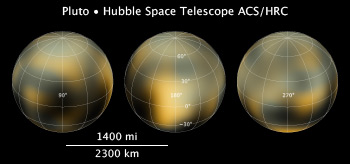Pity poor Pluto. The debate over its planethood has caused much consternation over the years. Part of the problem is that it’s so dinky and so far away! If it were closer, or bigger, we almost certainly wouldn’t be having this debate.
But whether or not you think Pluto should be part of the gang or not, one thing is certain: it’s a world unto itself. And to bring this point literally home, the Hubble Space Telescope has revealed the changing face of this tiny iceball:
These images, just released today (but taken in 2002), represent the most detailed surface map of Pluto ever taken. Even in Hubble’s Advanced Camera for Surveys Pluto is only a few pixels across, but it’s possible using sophisticated image processing techniques to tease out the detail seen.
Here’s a nifty animation of Pluto rotating using these maps:
Very cool. But these maps are more than just eye candy. They show significant changes on Pluto’s surface since the last maps were made using Hubble 16 years ago. Pluto’s north pole is brighter and the south pole darker, implying that material has migrated from one pole to the other, or at least that the poles are changing in different ways. Pluto orbits the Sun “on its side”, dramatically more tilted than Earth’s mere 23.5°. Right now, the north pole of the world is facing the Sun, meaning it’s summer on Pluto’s northern hemisphere (as it’ll remain for a long time, given Pluto’s 248 Earth-year long year).
Not only that, these images show that Pluto has reddened quite a bit in the past few years. This is one reason it took so long to release the images; Marc Buie, the astronomer who took them, saw some things in the data that were difficult to understand, and wanted to make sure they were correct. These images are composites of pictures taken using a blue and a green filter. During the time these observations were made, in 2000 - 2002, Pluto got much darker in blue, which was unexpected. Pluto’s moon, Charon, did not get any bluer, indicating that the cause was something intrinsic to Pluto and not that something weird happened with Hubble.
So why is Pluto redder now? That’s not clear. In general, ultraviolet light from the Sun interacts with the chemicals on Pluto, creating reddish organic molecules; this is seen on lots of distant, icy objects in the Kuiper Belt (the region past Neptune where Pluto orbits). Incredibly, even at the numbing distance of over 4 billion kilometers (3 billion miles) from the Sun, Pluto is still strongly affected by it. But this is happening while overall the northern hemisphere got brighter and the southern darker. You’d expect Pluto to get darker if it gets redder, so clearly there’s more going on here than meets the eye.
 These maps will prove crucial in planning the imaging run of the New Horizons probe, which will scream past Pluto in 2015. Having even a crude map in advance of the encounter will help scientists plan their limited time more carefully.
These maps will prove crucial in planning the imaging run of the New Horizons probe, which will scream past Pluto in 2015. Having even a crude map in advance of the encounter will help scientists plan their limited time more carefully.
Plus, these Hubble images may very well be the best view we’ll get until New Horizons gets to Pluto, for that matter. And whether you think Pluto is the littlest planet or one of the biggest of the Kuiper Belt Objects, it’s a fascinating place worthy of a lot more study. And in just a little more than five years we’ll see fantastic images of it, too. I can’t wait!
Video courtesy Emily Lakdawalla (and my thanks to her for a helpful conversation). Image and video credit: NASA, ESA, and M. Buie (SwRI)